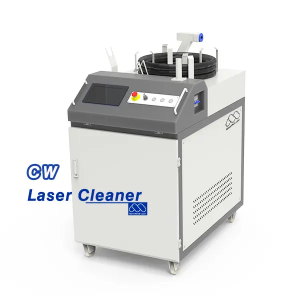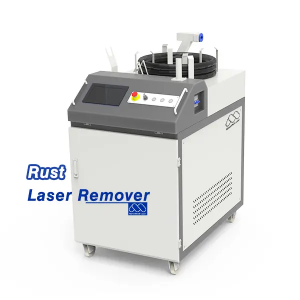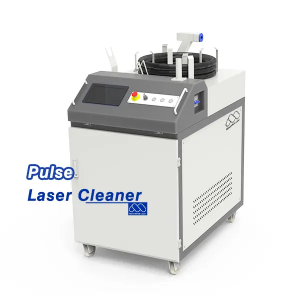Do Laser Cleaning Machines Really Work? [How to Choose in 2024]
The Straight & Simple Answer is:
Yes, they do and, it is an effective and efficient way to remove various types of contaminants from a wide range of surfaces.
These specialized tools utilize the power of focused laser beams to ablate, or vaporize, unwanted materials without damaging the underlying surface.
Choosing the Best Laser Rust Removal Machine can be difficult, that's where we come in.
Table of Content:
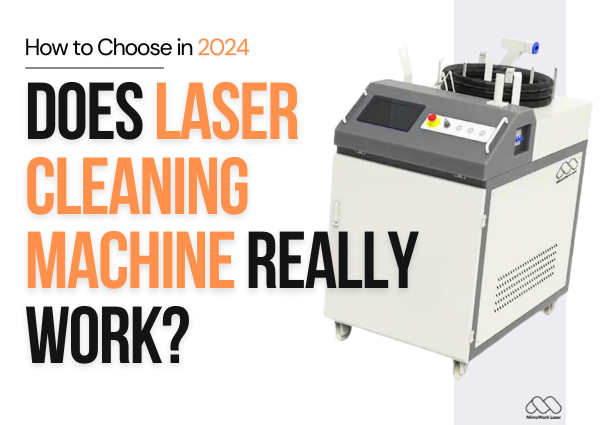
1. Do Laser Cleaning Machines Really Work? [Laser Removing Rust from Metal]
One of the key advantages of laser cleaning is its ability to selectively target and remove specific contaminants while leaving the base material intact.
This makes it particularly useful for delicate or sensitive surfaces, where traditional cleaning methods may be too abrasive or introduce unwanted chemicals.
From removing paint, rust, and scale on metal parts to cleaning delicate electronic components, laser cleaning has proven to be a versatile solution.
The effectiveness of laser cleaning machines largely depends on the specific parameters of the laser, such as wavelength, power, and pulse duration.
By carefully adjusting these settings, operators can optimize the cleaning process for different materials and contaminant types.
Additionally, the laser's focus and spot size can be tailored to target small, precise areas or cover larger surface areas as needed.
While laser cleaning machines do require a higher initial investment compared to some traditional cleaning methods.
The long-term benefits often outweigh the upfront cost.
The process is typically faster, more consistent, and produces less waste than manual or chemical-based cleaning.
Furthermore, the ability to automate the cleaning process can lead to significant time and labor savings, making laser cleaning an attractive option for industrial and commercial applications.
Ultimately, the question of whether laser cleaning machines really work comes down to the specific application and the desired cleaning results.

2. How to Choose the Best Laser Rust Removal Machine? [For You]
The first and most important step is to clearly define the specific cleaning requirements.
Including the type of contaminants, the material of the surface to be cleaned, and the desired level of cleanliness.
Once you have a clear understanding of your cleaning objectives, you can begin to evaluate the various laser cleaning machine options available on the market.
Some key considerations include:
1. Laser Type and Wavelength:
Different laser technologies, such as Nd:YAG, fiber, or CO2 lasers, operate at different wavelengths.
They all have varying strengths and weaknesses when it comes to cleaning different materials.
Choosing the right laser type is crucial for optimizing the cleaning process.
2. Power and Pulse Duration:
The laser's power output and pulse duration directly affect the cleaning efficiency and the ability to remove specific types of contaminants.
Higher power and shorter pulse durations are generally more effective for removing tough or stubborn deposits.
3. Spot Size and Beam Delivery:
The size of the laser's focused spot and the method of beam delivery (e.g., fiber optic, articulated arm) can determine the area that can be cleaned at once.
As well as the precision of the cleaning process.
4. Automation and Control Features:
Advanced automation and control capabilities such as programmable cleaning patterns, real-time monitoring, and data logging.
These features can improve the consistency and efficiency of the cleaning process.
5. Safety and Regulatory Compliance:
Laser cleaning machines must adhere to strict safety standards and regulatory requirements, particularly in industrial or hazardous environments.
Ensuring that the equipment meets all necessary safety and compliance criteria is essential.
6. Maintenance and Support:
Consider the ease of maintenance, availability of spare parts, and the level of technical support provided by the manufacturer or supplier.
These factors can impact the long-term reliability and cost of ownership of the laser cleaning machine.
By carefully evaluating these key factors and aligning them with your specific cleaning requirements, you can select the most appropriate laser cleaning machine for your application.
Consulting with experienced vendors or industry experts (That's Us!) can also be valuable in navigating the selection process and ensuring that you choose the right solution for your needs.
3. What Can you Clean with a Laser Cleaning Machine?
Laser cleaning machines are remarkably versatile, and capable of effectively removing a wide range of contaminants from a diverse array of surfaces.
The unique, non-contact nature of laser cleaning makes it particularly well-suited for cleaning delicate or sensitive materials that may be damaged by more aggressive cleaning methods.
One of the primary applications of laser cleaning is the removal of surface coatings, such as paints, varnishes, and powder coatings.
The high-energy laser beam can precisely vaporize these coatings without harming the underlying substrate, making it an ideal solution for restoring the appearance and condition of metal parts, sculptures, and historical artifacts.
In addition to surface coatings, laser cleaning machines are also highly effective at removing rust, scale, and other oxidation layers from metal surfaces.
This is particularly useful in the automotive, aerospace, and manufacturing industries, where maintaining the integrity and appearance of metal components is crucial.
Another application of laser cleaning is the removal of organic contaminants, such as grease, oil, and various types of dirt and grime.
This makes it a valuable tool for cleaning electronic components, precision instruments, and other sensitive equipment that cannot tolerate the use of harsh chemicals or abrasive methods.
Beyond these common applications, laser cleaning machines have also proven effective in a variety of specialized tasks.
Including the removal of carbon deposits from engine components, the cleaning of delicate artwork and museum artifacts, and the preparation of surfaces for subsequent coating or bonding processes.
The versatility of laser cleaning is largely due to the ability to precisely control the laser parameters, such as wavelength, power, and pulse duration, to optimize the cleaning process for different materials and contaminant types.
This level of customization allows laser cleaning machines to be adapted to a wide range of industrial, commercial, and conservation applications.
We Don't Settle for Mediocre Results, Neither Should You
4. How Fast is Laser Cleaning?
One of the key advantages of laser cleaning machines is their ability to perform cleaning tasks quickly and efficiently, often significantly faster than traditional cleaning methods.
The speed of the laser cleaning process is influenced by several factors, including:
The type and characteristics of the contaminant, the material of the surface being cleaned, and the specific parameters of the laser system.
In general, laser cleaning is a relatively fast process, with cleaning rates ranging from a few square centimeters per second to several square meters per minute, depending on the specific application.
The speed of laser cleaning is largely due to the non-contact nature of the process, which allows for rapid and targeted removal of contaminants without the need for physical contact or the use of abrasive or chemical agents.
Additionally, the ability to automate the cleaning process further enhances the overall efficiency, as laser cleaning machines can operate continuously with minimal human intervention.
Another factor that contributes to the speed of laser cleaning is the ability to precisely control the laser parameters to optimize the cleaning process.
By adjusting the laser's power, pulse duration, and spot size, operators can maximize the removal rate of specific contaminants while minimizing the risk of damage to the underlying surface.
It's important to note that the actual cleaning speed can vary depending on the specific application and the desired level of cleanliness.
In some cases, a slower, more controlled cleaning process may be necessary to ensure the complete removal of stubborn contaminants or to preserve the integrity of delicate surfaces.
Overall, the speed and efficiency of laser cleaning make it a highly attractive option for a wide range of industrial, commercial, and conservation applications, where time and cost savings are critical factors in the cleaning process.
5. Is Laser Cleaning Abrasive?
One of the key advantages of laser cleaning technology is that it is a non-abrasive cleaning method, which makes it well-suited for use on delicate or sensitive surfaces.
Unlike traditional cleaning techniques that rely on physical abrasion or the use of harsh chemicals.
Laser cleaning utilizes the energy of a focused laser beam to vaporize and remove contaminants without coming into direct contact with the underlying material.
The non-abrasive nature of laser cleaning is achieved through the precise control of the laser parameters, such as wavelength, power, and pulse duration.
The laser beam is carefully tuned to target and remove the specific contaminants on the surface without causing any physical damage or alterations to the underlying material.
This non-abrasive cleaning process is particularly beneficial when working with fragile or high-value materials, such as historical artifacts, fine art, and delicate electronic components.
By avoiding the use of physical abrasion or aggressive chemicals, laser cleaning helps to preserve the integrity and surface characteristics of these sensitive items, making it a preferred cleaning method in many conservation and restoration applications.
Furthermore, the non-abrasive nature of laser cleaning also allows it to be used on a wide range of materials, including metals, plastics, ceramics, and even composite materials.
It's important to note, however, that while laser cleaning is generally a non-abrasive process, the specific cleaning parameters and the characteristics of the contaminants and surface being cleaned can affect the level of interaction between the laser and the material. In some cases, a more careful and controlled approach may be necessary to ensure that the cleaning process remains entirely non-abrasive.
6. Can Laser Cleaning Replace Sand Blasting?
As laser cleaning technology continues to evolve and become more widely adopted, the question of whether it can effectively replace traditional cleaning methods, such as sand blasting, has been a subject of growing interest.
While there are some similarities between laser cleaning and sand blasting, in terms of their ability to remove contaminants and restore surfaces, there are also several key differences that make laser cleaning a compelling alternative in many applications.
One of the primary advantages of laser cleaning over sand blasting is its non-abrasive nature.
As previously discussed, laser cleaning utilizes the energy of a focused laser beam to vaporize and remove contaminants without physically impacting the underlying surface.
In contrast, sand blasting relies on the use of abrasive media, such as sand or small glass beads, which can potentially damage or alter the surface of the material being cleaned.
This non-abrasive characteristic of laser cleaning makes it particularly well-suited for use on delicate or sensitive materials, where the risk of surface damage is a critical concern.
Additionally, laser cleaning can be more precisely targeted, allowing for the selective removal of contaminants without affecting the surrounding areas, which can be particularly beneficial in applications where precise control is required.
Another key advantage of laser cleaning over sand blasting is the ability to clean complex or hard-to-reach areas.
The focused and highly controllable nature of the laser beam allows it to access and clean areas that may be difficult or impossible to reach with traditional sand blasting equipment.
Furthermore, laser cleaning is generally a faster and more efficient process than sand blasting, particularly for smaller-scale or localized cleaning tasks.
The non-contact nature of the laser cleaning process, combined with the ability to automate the cleaning procedures, can result in significant time and cost savings compared to traditional sand blasting methods.
However, it's important to note that while laser cleaning can be a highly effective alternative to sand blasting in many applications, the choice between the two methods ultimately depends on the specific cleaning requirements, the characteristics of the materials involved, and the overall objectives of the cleaning process.
In some cases, a combination of laser cleaning and other techniques may be the most optimal solution.
Video Demo: Laser Cleaner
If you enjoyed the video, why not consider subscribing to our YouTube channel? :)
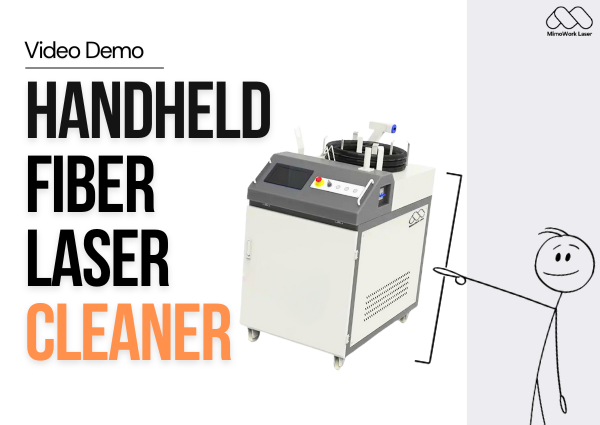

7. Commonly Asked Questions about Laser Cleaning Machine
1. Do Laser Machines use a lot of Electricity?
In Some Cases, Yes, laser cleaning machines require a significant amount of electricity to power the high-energy laser systems.
The exact power consumption can vary depending on the size and power output of the specific laser used.
2. Can Laser Cleaning Remove Paint?
Yes, laser cleaning is highly effective at removing various types of surface coatings, including paints, varnishes, and powder coatings.
The laser energy can precisely vaporize these coatings without damaging the underlying substrate.
3. How Long do Laser Cleaners Last?
Laser cleaning machines are designed to be durable, with many models having an expected lifespan of 10-15 years or more with proper maintenance and care.
The lifetime of the laser source itself can vary, but it is often replaceable.
4. Are Laser Cleaning Machines Safe?
When used properly and with appropriate safety precautions, laser cleaning machines are generally considered safe.
However, the high-energy laser beams can pose risks, so it is essential to follow safety protocols and use the equipment in a controlled environment.
5. Can you Hire a Laser Cleaner?
Yes, many companies and service providers offer laser cleaning services, allowing customers to have their materials or equipment cleaned without the need to purchase a laser cleaning machine themselves.
Yes, but if you have a lot of projects involving cleaning, purchasing a laser cleaning machine might be a more cost-effective approach.
6. Can you Remove Rust with a Laser?
Yes, laser cleaning is an effective method for removing rust, scale, and other oxidation layers from metal surfaces, making it a valuable tool in industries such as automotive, aerospace, and manufacturing.
As matter of fact, here is another article about Laser Rust Removal.
7. Does Laser Cleaning Remove Metal?
Laser cleaning is typically designed to remove contaminants and coatings from the surface of materials without causing significant damage to the underlying substrate, including metals.
However, the laser parameters must be carefully controlled to avoid removing or altering the metal itself.
8. Does Laser Cleaning Work on Wood?
Laser cleaning can be effective on certain types of wood, particularly for the removal of surface coatings, dirt, or other contaminants.
However, the laser parameters must be adjusted to avoid damaging or charring the delicate wood surface.
9. Can you Laser Clean Aluminum?
Yes, laser cleaning is a suitable method for cleaning aluminum surfaces, as it can effectively remove various types of contaminants, coatings, and oxidation layers without causing significant damage to the aluminum substrate.
Machine Recommendations for Laser Cleaning Machine
▶ About Us - MimoWork Laser
Elevate your Production with Our Highlights

MimoWork has been committed to the creation and upgrade of laser production and developed dozens of advanced laser technology to further improve clients' production capacity as well as great efficiency. Gaining many laser technology patents, we are always concentrating on the quality and safety of laser machine systems to ensure consistent and reliable processing production. The laser machine quality is certificated by CE and FDA.
Get More Ideas from Our YouTube Channel
You Might be Interested in:
We Accelerate in the Fast Lane of Innovation
Post time: May-24-2024


